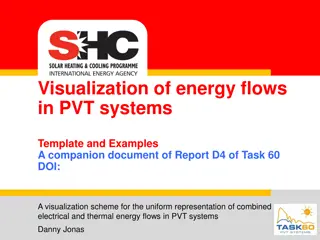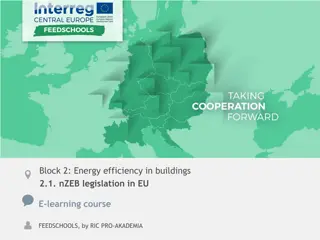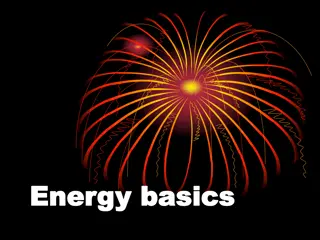Understanding Technology in Energy Systems Analysis
This content delves into the concept of technology within energy systems analysis. It explains the critical role of technology in producing, converting, and consuming commodities, with examples like power stations and water treatment plants. The discussion covers various aspects such as technical and economic characteristics, model parameters, and the CLEWs framework that analyzes physical systems and scenarios. It emphasizes the importance of bottom-up analysis, representing full value chains, and assessing strategies for long-term sustainability.
Download Presentation

Please find below an Image/Link to download the presentation.
The content on the website is provided AS IS for your information and personal use only. It may not be sold, licensed, or shared on other websites without obtaining consent from the author. Download presentation by click this link. If you encounter any issues during the download, it is possible that the publisher has removed the file from their server.
E N D
Presentation Transcript
https://lh6.googleusercontent.com/Ly_PhcwOrV7ieHqPjBUUdqFiAGODtzJmBwrIeHLHNXmO2gAmLok-TdTBr_d3BtnUCDenebmvgE80MCYN8Vorq6tctapX-MHkCI-nBydPkMCIQlU3bY5E3A4URgaFKH9_3Y3ixC7nhttps://lh6.googleusercontent.com/Ly_PhcwOrV7ieHqPjBUUdqFiAGODtzJmBwrIeHLHNXmO2gAmLok-TdTBr_d3BtnUCDenebmvgE80MCYN8Vorq6tctapX-MHkCI-nBydPkMCIQlU3bY5E3A4URgaFKH9_3Y3ixC7n https://lh4.googleusercontent.com/jDjKyzhdhZWMxUNi7z6qAJzpBZEkOBbfd9pxc_hw_VhHxoTvuhQehahE7VFIlqmGgpn-yNdL2HsCN5L4vZpsZzJoIFrGq37CRI-kV8YM3EbnBWnbkWxvjk9tYWPG2bomkqh_um96 https://lh5.googleusercontent.com/QwAyBzI_HrdO1gj0yaFRi0OiqghV8sMirzKBHzFYtGIWVVnBeuDuBR9_JP1vo9XJKYzGCL0sd1ZodqNBZxjvOYILUxRDdlxRQLuJNl1PB5k_6S9avTsqb2zL8U1SbUj7jo_r0pHa OpTIMUS.community Introduction to integrated CLEW models and OSeMOSYS
The CLEWs framework Time horizon typically one or more decades Intended for longer term assessments and studies Bottom-up analysis Representation of physical systems Full value chain (e.g. well to wheel or field to fork ) Identify cost-effective strategies subject to constraints Scenario based analysis Explores alternatives, risks and uncertainties through scenarios and sensitivity analysis Assesses the role of technology and technology change Tests policies and measures Flexible Model user chooses system boundaries Model user chooses level of detail Model user chooses geographical coverage
Bottom-up analysis Representation of physical systems Each technology (component) of the system is characterized by its technical characteristics e.g. installed capacity, efficiency, availability etc. and economic characteristics e.g. investments costs, O&M costs etc.
Model parameters and variables Inputs Outputs Demand curves Technology performance Technology cost (capital, O&M) Commodity cost (extraction cost, import cost) Cost of capital Emission intensity Constraints (environmental, regulatory, policy, market etc. ) Investment (physical units and $ s) Total capacity Operating costs Asset utilization Output (physical units) Fuel expenditures Emissions Shadow prices
What is a technology? Terminology inherited from energy systems analysis An asset, stock or process that produces, converts or consumes one or more commodities.
Technology example #1 Power station A physical asset that turns an input fuel (e.g. coal) and perhaps other resources (e.g. water for cooling) and produces an output - electricity Coal Electricity Coal PP Water
Technology example #2 Water treatment plant Facilities and equipment that turn untreated water into potable water, consuming energy (electricity) to do so Untreated water Potable water Water TP Electricity
Technology example #3 Coal mine Equipment and facilities that extract a commodity (coal) from a natural stock (resource) coal deposit Coal Coal Mine
Technology example #4 Maize farming Application of physical equipment and management practices to transform takes a range of inputs (e.g. a land resource, water, energy, fertilizer etc.) into an output maize. Maize Precipitation Land Evapotranspiration Maize farming Diesel Runoff Ground water Irrigation
Bottom-up analysis: Simplified illustration The components are linked together in a flow network, representing a web of interconnected value chains Electricity Coal Coal mine Coal PP Home appliances Natural gas Gas field Gas PP Industrial equipment Water Treated Water Water resource Water Treatment Drinking water Land type X Maize Land resource Maize farming Household nutrition
Building a system representation Step 1: Create commodities Step 2: Create technologies Step 3: Create the links in the value chain (i.e. define the inputs and outputs for each technology)
Exercise 1 Coal Coal mine Coal PP Electricity Natural gas Gas field Gas PP
Exercise 1 (continued) Create 3 commodities: e.g. COA (Coal), GAS (Natural gas), ELC (Electricity) Instructions: In MoManI click; Models>Example>Edit set data> (On this screen you can create members of the different Under Commodity click enter data Click + , then enter name and description Click save additional sets)
Exercise 1 (continued) Create 4 technologies: e.g.MINCOAL (Coal mine), MINGAS (Gas field), ECOAL (Coal-fired power plant) and EGAS (Gas-fired power plant) Instructions: In MoManI click; Models> your model name >Edit set data> (You are back to the screen where you can create additional members of the different sets) Under Technology click enter data Click + , then enter name and description Click save
Technology Activity The concept of technology activity represents the rate at which a technology is doing something (e.g. producing an output) Factors such as input, output and capacity is related to technology activity through different parameters (more on that on the next slide). It is a decision variable, something that is optimized (i.e. model outcome) Coal Electricity Coal PP Water
Technology input The parameter InputActivityRatio defines the relationship between the input of a specific commodity to the activity of a technology It is simply the ratio of the input to the activity A non-zero value for the InputActivityRatio for a commodity/technology pair therefore means that that technology requires at least some amount of that commodity to produce an output Example: If the parameter value for the InputActivityRatio for a gas fired power plant is 2 for the commodity gas then two units of gas is required for every unit of activity A technology can have more than one input commodity
Technology output The parameter OutputActivityRatio defines the relationship between the output of a specific commodity to the activity of a technology It is simply the ratio of the output to the activity A non-zero value for the OutputActivityRatio for a commodity/technology pair therefore means that this technology is producing/generating at least some amount of that commodity Example: If the parameter value for the OutActivityRatio for a gas fired power plant is 1 for the commodity electricity then one unit of electricity is generated for every unit of activity A technology can have more than one output commodity
Input-output relationship Since the InputActivityRatio and Output-ActivityRatios relate inputs and outputs to activity - combined they also relate inputs to outputs. Example 1: An InputActivityRatio of 2 and an OutputActivityRatio of 1 means that 2 units of input (e.g. gas) is required to produce 1 unit of output (e.g. electricity). This would represent an efficiency of 50% if both inputs and outputs are measured in the same units (e.g. PJ) 2PJ Gas 1PJ Electricity XYZ Activity (Gas power plant)=1
Input-output relationship (continued) Example 2: If, for technology XYZ the: InputActivityRatio for commodity A = 3 InputActivityRatio for commodity B = 0.5 OutputActivityRatio for commodity C = 1 Then for a technology activity of one: 3xA 1xC XYZ 0.5xB Activity (XYZ)=1
Input-output relationship (continued) Example 3: If, for technology XYZ the: InputActivityRatio for commodity A = 1 OutputActivityRatio for commodity B = 0.5 OutputActivityRatio for commodity C = 0.5 Then for a technology activity of one: 1xA 0.5xB XYZ 0.5xC Activity (XYZ)=1
Input-output relationship (continued) Example 4: Note that OutputActivityRatios do not have to sum to 1 Also note that if the units of measurement are different the sum of outputs can be higher than the sum of inputs So if, for technology XYZ the: InputActivityRatio for commodity A = 2 OutputActivityRatio for commodity B = 4 OutputActivityRatio for commodity C = 1 Then for a technology activity of one: 2xA 4xB XYZ 1xC Activity (XYZ)=1
Exercise 2 The next step is to link the 3 commodities and 4 technologies created in Exercise 1 into a network Coal Coal mine Coal PP Electricity Natural gas Gas field Gas PP
Exercise 2 (continued) Enter OutputActivityRatio = 1 for the relevant fuels for all technologies. That is: OutputActivityRatio MINCOAL(Coal)=1 OutputActivityRatio MINGAS(Gas)=1 OutputActivityRatio ECOAL(ELC)=1 OutputActivityRatio EGAS(ELC)=1
Exercise 2 (continued) Instructions: In MoManI click; Models > your model name >Scenarios>enter data This takes you to a screen that allows you to edit parameter values Select enter data under OutputActivityRatio Fix the region, mode-of-operation and technology dimensions Select the MINCOAL technology Enter 1 for Coal for all years (note: you can use the copy function) Save Repeat for the other 3 technologies
Exercise 2 (continued) Enter InputActivityRatio for the relevant fuels for all technologies. Assume that all flows are measured in PJ and that: The thermodynamic efficiency of the coal-fired power plant is 33% The thermodynamic efficiency of the gas-fired power plant is 50%
Exercise 2 (continued) Instructions: In MoManI click; Models>Example>Scenarios>enter data This takes you back to the screen that allows you to edit parameter values Select enter data under InputActivityRatio Fix the region, mode-of-operation and technology dimensions Select the ECOAL technology Calculate the correct InputActivityRatio for COAL for and enter it for all years (note: you can use the copy function) Save Repeat for the gas-fired power plant
Exercise 2 (continued) You have now created the small network structure below. Coal Coal mine Coal PP Electricity Natural gas Gas field Gas PP
Cost optimization Starting point: Demand for products and services (e.g. water supply, grains, lighting etc.) System: A set of interconnected value chains consisting of existing and candidate (potential new) assets. Objective: Deploy these assets in a manner that meets the specified demands at the lowest total system costs Coal Coal mine Coal PP Electricity Natural gas Gas field Gas PP
Cost optimization technology choice The optimization is a mathematical process that searches for a solution that satisfies all demands at the lowest cost, subject to constraints. In our example the result would simply be the combination of gas and coal fired electricity generation that meets demand at the lowest cost Coal Coal mine Coal PP Electricity Natural gas Gas field Gas PP
Cost optimization technology choice The optimization process will: Adjust the capacity (Investment) and operation (Activity) of each technology to find the combination that meets a specified demand (e.g. 100 PJ) at the lowest possible cost Coal Coal mine Coal PP Electricity 100PJ Natural gas Gas field Gas PP Minimize (Total cost)
Cost parameters The main cost parameters in Osemosys are: CapitalCost The per unit investment cost of adding to existing capacity stock (e.g. $/kW, $/PJ/a, $ per Mm3/a etc. ) FixedCost The per unit fixed O&M costs charged to every unit of installed capacity (e.g. $/kW, $/PJ/a, $ per Mm3/a etc. ) VariableCost The per unit variable O&M costs charged to every unit of technology activity(e.g. $/MWh, $/GJ, $ per m3) There are also other cost parameters in Osemosys but we will get back to those at a later stage
Cost parameters (continued) Cost parameters are time-dependent: Year 1 Year 2 Year 3 Year 4 CapitalCost [$/kW] 2000 1900 1800 1700 IF there is an investment in year 2, IF the same investmemt took place in year 4 the cost would be 1700$/kW * 100 MW * 1000 kW/MW = $ 170 mill then a cost of $ 1900 per unit of installed capacity is incurred. e.g. an investment of 100MW would incur a cost of 1900$/kW * 100 MW * 1000 kW/MW = $ 190 mill Capital costs are only occurred when there is an investment
Cost parameters (continued) A technology incurs FixedCost during any year when there is any installed capacity Year 1 Year 2 Year 3 Year 4 FixedCost [$/kW] 50 55 60 65 IF there is installed capacity in years 1-3 IF the retired capacity is retired before the beginning of the 4th year, no costs will be incurred in this year then a cost of $ 50, 55, 60 per unit of installed capacity is incurred. e.g. capacity of 100MW would incur a cost of 50$/kW * 100 MW * 1000 kW/MW = $ 5 mill in year 1
Cost parameters (continued) A technology incurs VariableCost for every unit of activity Year 1 Year 2 Year 3 Year 4 VariableCost [$/GJ] 2 2 2 2 IF there is activity in any year IF there is no activity no costs are incurred then a cost of 2 $/GJ is incurred e.g. activity of 1 PJ would incur a cost of 2$/GJ * 1 PJ * 10^6 GJ/PJ= $ 2 mill
Cost optimization technology choice Let us assume that: The demand for electricity is 100 PJ There are no losses There are no restrictions The total cost of providing coal-fired electricity is $15/GJ and that the cost of providing gas-fired electricity is $25/GJ (ignoring for the time being time, operational and cost structure issues) Costs are measured in millions of dollars
Cost optimization technology choice This can be illustrated as follows: 120 The orange line represents the minimum electricity generation (i.e. all combinations resulting in total generation of 100 PJ) Gas fired electricity generation[PJ] 100 80 It can be 100 PJ from gas 60 It can be 100 PJ from coal 40 Or any combination of the two that produces at least 100 PJ in total 20 0 0 50 100 150 Coal fired electricity generation [TJ]
Cost optimization technology choice Furthermore: The blue line represents the total cost of generating the 100 PJ for different combinations of gas and coal fired electricity @ $m25 and $m15 per PJ respectively. 120 3000 Gas fired electricity generation [PJ] 100 2500 Total cost [$ million 80 2000 60 1500 The total cost decreases as a higher share of electricity is generated by the cheaper coal fired power plant. 40 1000 20 500 The cheapest solution is simply to generate all power from coal. This costs $1.5 bill. 0 0 0 50 100 150 Coal fired electricity generation [PJ]
Exercise 3 Which of the parameters from the last slide would you use to represent the example on technology choice (i.e. $/25 per GJ for gas and $15 per GJ for coal? Populate the model with these assumptions What other assumption is missing before we have replicated the example above?
Demand For any commodity the user can specify an exogenous demand. These demands drive the solution, as the aim of the model is to minimize the cost of meeting them. There are two parameters that can be used to specify demand AccumulatedAnnualDemand which specifies a demand on an annual level SpecifiedAnnualDemandwhich specifies a demand where time-of-use is important (such as daily fluctuations in electricity demand and This needs to be combined with the parameter SpecifiedDemandProfile which sets the time-of-use profile
Exercise 3 Enter the 100 PJ demand using the AccumulatedAnnualDemand parameter. Let it be constant for all years. Now run the model! Explore the results: Do they match our expectations?
Cost optimization technology choice In this example the problem was trivial. It was possible to see what the cheapest outcome was without using models However, once the number of technologies increases, the complexity of the network increases and the cost structures become more complicated one needs models to identify the lowest cost solutions.
Cost optimization technology choice In this example the problem was trivial. It was possible to see what the cheapest outcome was without using models However, once the number of technologies increases, the complexity of the network increases and the cost structures become more complicated one needs models to identify the lowest cost solutions. Let us start by looking at cost structures and introduce investment costs , fixed O&M costs and fuel costs But first we need to introduce three other parameter
Operational life The number of years a technology will be in operation Example: If a gas-fired power plant is specified to have an OperationalLife of 30 years, it will operate for 30 years after the initial investment and then the capacity will be retired That is: the initial investment that was added to total capacity at the beginning of year 1 will be subtracted from the total at the end of the 30th year.
Availability Factor The AvailabilityFactor determines what share of total theoretical output a technology could produce Example: If a gas-fired power plant is specified to have an AvailabilityFactor of 90% years and an installed capacity of 100 MW it could produce up to 100 MW * 8760 hours * 90% = 788 GWh in a year. This could be 90% load 100% of the time or 100% load 90% of the time, or anything in between Note that in Osemosys/MoManI the AvailabilityFactor is entered as a fraction so that the 90% availability would be entered as 0.9
CapacityToActivityUnit CapacityToActivityUnit Sets the relationship between capacity and activity Represents the ability of a unit of capacity to generate activity (e.g. the number of units of activity that could be generated by one unit of capacity running at 100% load for 1 year) Example 1: If the capacity of a refinery is measured in barrels per year and the output is in barrels then the CapacityToActivityUnit is simply 1 However, if you use the more common unit of barrels per day then the CapacityToActivityUnit would be: 365
CapacityToActivityUnit (continued) Example 2: What is the CapacityToActivityRatio of a power station with capacity measured in GW and activity measured in PJ? 1 Watt = 1 Joule/Second 1 Watt = 1 Joule/Second * 3600 Second/hour = 3600 Joules/hour 1 Watt = 3600 Joules/hour * 8760 Hours/year 1 Watt = 31536000 Joules/year = 31.536 Megajoules/year Times 10^9 to go from Watt to GW 1 GW = 31.536 PJ/year Summer School on Modelling Tools for Sustainable Development 12-30 June 2017, ICTP, Trieste. Organizers: UNDESA, UNDP, ICTP, Cambridge University, KTH 9/17/2024 48
Exercise 4 Populate the model with the following data Parameter Units MINCOA MINGAS ECOA EGAS AvailabilityFactor Fraction 1 (100%) 1 (100%) 1 (100%) 1 (100%) CapitalCost $/kW 0 0 2200 1250 FixedCost $/kW/a 0 0 75 30 VariableCost $/GJ 3 7 0 0 OperationalLife Yrs 30 30 30 30 CapacityTo- ActivityUnit PJ/(PJ/a), GJ/kW 1 1 31.536 31.536 Then download the executable and run the model, and explore the results























